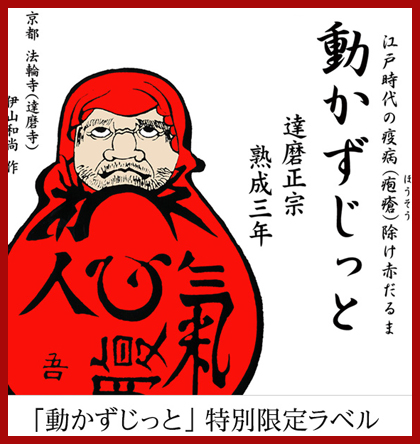[ . BACK to TOP . ]
:::::::::::::::::::::::::::::::::::::::::::::::::::::::::::::::::::::::::::::::::::::::::::::::::::::
.................................. December 2006
Kabocha Daruma as Pumpkinかぼちゃ達磨, かぼちゃだるま
Fukutoku Senbei <> Waffles for Good Luck from Kanazawa福徳せんべい
BOOKs about Daruma
Sake, Nihonshuu, 日本酒, the Drink of Japan Index of my Sake Articles
Katsuyama Wooden Daruma 勝山宿の木材だるま
New Book : Daruma Encyclopedia 開運だるま大百科, by Nakamura san
Gustav Jacoby, a German Art Collector
デザイナーズだるま and
Ring with Daruma, Lujeiダルマリング.
Cha tsutsu, chazutsu 茶筒 Daruma as Container for Tea Leaves
Tsuki Hyakushi : One Hundred Aspects of the Moon : Daruma Woodblock. 月百姿 by Tsukioka Yoshitoshi
Doi Shrine, Mimasaka and the Old Road of Izumo
土井神社と出雲街道
.................................. November 2006
Nadebotoke and Binzuru, the Arhat 撫で仏と 賓頭盧, びんずる、びんづる ビンヅル
Shutsuzan Shaka : Why is Daruma covering his hands under his robe? 出山釈迦
.................................. October 2006
Temple Mokubo-Ji and Umewakamaru 木母寺 (もくぼじ) と 梅若丸伝説
Takadono tatara, Metal Manufacturing高殿鑪 たかどのたたら
..... The Japanese Swordmaking
Gustav Jacoby, a German Art Collector
Encho En, Chinese Park in Tottori 中国庭園 燕趙園
Temple Oohirayama Konpira-In, Kurayoshi 大平山 金毘羅院
..... Fudo Statues at Konpira-In
..... Kannon with 1000 Arms at Konpira-In
Mitoku San, Temple Sanbutsu-Ji, Nage-ire Doo 三徳山三仏寺 投入堂
..... Six-sided Nyorai Stele, rokumentoo 六面塔 and Six Nyorai
Zao Gongen, a Mountain Deity 蔵王権現
Alphabetical Index of the Daruma Museum
:::::::::::::::::::::::::::::::::::::::::::::::::::::::::::::::::::::::::::::::::::::::::::::::::::::
worldkigo
12/30/2006
12/19/2006
Fukutoku Senbei
[ . BACK to DARUMA MUSEUM TOP . ]
:::::::::::::::::::::::::::::::::::::::::::::::::::::::::::::::::::::::::::::::::::::::::::::::::::::
Fukutoku Senbei 福徳せんべい
Lucky Waffles from the Kaga Domain
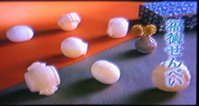
When the Lord Maeda of the Kaga domain rebuild the tower Ni no Maru of his castel in 1809, he had special waffles made for the final celebration. Inside these waffles were small clay toys like the beckoning cat, other sweets or little statues of auspicious deities, like Tenjin Sama. The sugary sweets are called "Gold Flower Sugar" (kinkatoo 金花糖).
One of these wafers, in the form of an auspicious hammer (kozuchi) contained a small clay doll of a female princess Daruma, which is a speciality of this domain.
I took the photos from a TV program on sweets, they are a bit wobbely.
The sweets were made by Rakugan Moroe-ya 落雁諸江屋 are made since 1849. Altogether they made 10 different types. Now these sweets are a special fare for the New Year Celebrations. Some people like to shake the closed waffles and guess what is inside, which makes for a nice game during a New Year Party.
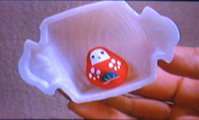
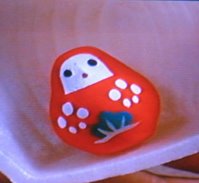
:::::::::::::::::::::::::::::::::::::::::::::::::::::::::::::::::::::::::::::::::::::::::::::::::::::
The Store Moroeya features other Kanazawa sweets for the New Year 金沢の新春菓子, for example a type of
Fortune Cookies 辻占福寿草They contain slips of paper with riddles in the local language.
Wishing for a long life at the New Year, 金澤夢菓子「久寿玉」contains six different types of sweets. Some contain items to play with.
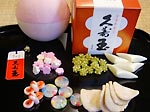
Copyright © The Yomiuri Shimbun.
:::::::::::::::::::::::::::::::::::::::::::::::::::::::::::::::::::::::::::::::::::::::::::::::::::::
Quote from Yomiuri Shinbun
福徳せんべい 中から天神様や金花糖
少し早いが、正月用菓子を紹介する。1849年(嘉永2年)創業、金沢の老舗和菓子店「落雁諸江屋(らくがんもろえや)」が作っている福徳せんべいである。
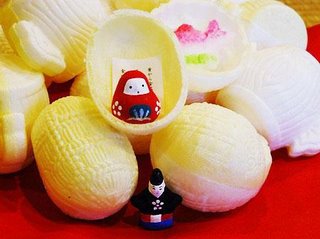
俵や打ち出の小づちをかたどったもち米せんべいの中に、天神様や宝船などの土人形や砂糖菓子のおまけが入っている。土人形は20種類、砂糖菓子は10種類。細部まで良くできていて、とくに招き猫やこま犬、ふくら雀(すずめ)の顔立ちがかわいらしい。新年の縁起を占う菓子として、金沢に伝わっているものだそうだ。
私は招き猫の土人形がどうしても欲しくて、いくつも開けてしまった。耳元で振ると、ゴロンゴロンと音がする。その音で中身の大きさや形に見当をつけるのだが、なかなか当たらない。新年会など、みんなが集まったときに取り出せば、盛り上がること間違いない。砂糖菓子はすっきりとした甘さで、コーヒーに添えてもおいしい。
この菓子は1809年(文化6年)、金沢城二の丸を新築する際、当時の加賀藩主が祝賀用に作らせたのが始まり。明治時代、正月用の縁起菓子として市内の菓子屋に広まったが、いまは落雁諸江屋だけで作っているという。
砂糖菓子は金花糖(きんかとう)とも呼ばれ、煮詰めた氷砂糖を木型に流し込み、固めてから着色している。金沢名物のひとつで、加賀藩では、祝いの日、家臣が藩主に金花糖で作った菓子を献上する習わしがあったそうだ。
みごとな金花糖を作るには、精密な木型が必要だ。金沢に近い富山県南砺市の井波地区はひな人形や欄間彫刻など木彫りで有名な場所で、ここで金花糖や落雁の木型が盛んに彫られていたのである。
福徳せんべいに、言葉遊びをするための紙が入った菓子、落雁などをセットにした正月用菓子文庫もある。(フードライター)
Copyright © The Yomiuri Shimbun.
:::::::::::::::::::::::::::::::::::::::::::::::::::::::::::::::::::::::::::::::::::::::::::::::::::::
Another kind of normal senbei, with the taste of soy sauce.
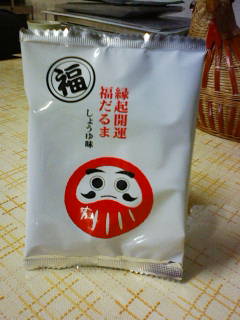
Photo from my friend Kyoko.
:::::::::::::::::::::::::::::::::::::::::::::::::::::::::::::::::::::::::::::::::::::::::::::::::::::
乙女の金沢 otome no Kanazawa
Sweets for the Girls of Kanazawa
Exhibition

WASHOKU
Wagashi Sweets from Kanazawa 金沢に和菓子
:::::::::::::::::::::::::::::::::::::::::::::::::::::::::::::::::::::::::::::::::::::::::::::::::::::
. Toyama Folk Art - 富山県 .
fukutoku ningyoo 福徳人形 Fukutoku dolls
fukutoku senbei 福徳煎餅

source : asahi-net.or.jp
These small auspicious dolls have been used by the local sweet makers to decorate for the New Year and add them to the shopping bags of their customers.
Baked in waffles they are the noisy
garagara senbei がらがら煎餅.
:::::::::::::::::::::::::::::::::::::::::::::::::::::::::::::::::::::::::::::::::::::::::::::::::::::
Sweets with Daruma, Wagashi, Dagashi
Sweets from Japan (wagashi) and Haiku
Onna Daruma, Daruma as a Woman
:::::::::::::::::::::::::::::::::::::::::::::::::::::::::::::::::::::::::::::::::::::::::::::::::::::::::::::::::::::::::::
[ . BACK to DARUMA MUSEUM TOP . ]
[ . BACK to WORLDKIGO . TOP . ]
ーーーーー #fukutoku - - - - -
:::::::::::::::::::::::::::::::::::::::::::::::::::::::::::::::::::::::::::::::::::::::::::::::::::::::::::::::::::::::::::
:::::::::::::::::::::::::::::::::::::::::::::::::::::::::::::::::::::::::::::::::::::::::::::::::::::
Fukutoku Senbei 福徳せんべい
Lucky Waffles from the Kaga Domain

When the Lord Maeda of the Kaga domain rebuild the tower Ni no Maru of his castel in 1809, he had special waffles made for the final celebration. Inside these waffles were small clay toys like the beckoning cat, other sweets or little statues of auspicious deities, like Tenjin Sama. The sugary sweets are called "Gold Flower Sugar" (kinkatoo 金花糖).
One of these wafers, in the form of an auspicious hammer (kozuchi) contained a small clay doll of a female princess Daruma, which is a speciality of this domain.
I took the photos from a TV program on sweets, they are a bit wobbely.
The sweets were made by Rakugan Moroe-ya 落雁諸江屋 are made since 1849. Altogether they made 10 different types. Now these sweets are a special fare for the New Year Celebrations. Some people like to shake the closed waffles and guess what is inside, which makes for a nice game during a New Year Party.


:::::::::::::::::::::::::::::::::::::::::::::::::::::::::::::::::::::::::::::::::::::::::::::::::::::
The Store Moroeya features other Kanazawa sweets for the New Year 金沢の新春菓子, for example a type of
Fortune Cookies 辻占福寿草They contain slips of paper with riddles in the local language.
Wishing for a long life at the New Year, 金澤夢菓子「久寿玉」contains six different types of sweets. Some contain items to play with.

Copyright © The Yomiuri Shimbun.
:::::::::::::::::::::::::::::::::::::::::::::::::::::::::::::::::::::::::::::::::::::::::::::::::::::
Quote from Yomiuri Shinbun
福徳せんべい 中から天神様や金花糖
少し早いが、正月用菓子を紹介する。1849年(嘉永2年)創業、金沢の老舗和菓子店「落雁諸江屋(らくがんもろえや)」が作っている福徳せんべいである。

俵や打ち出の小づちをかたどったもち米せんべいの中に、天神様や宝船などの土人形や砂糖菓子のおまけが入っている。土人形は20種類、砂糖菓子は10種類。細部まで良くできていて、とくに招き猫やこま犬、ふくら雀(すずめ)の顔立ちがかわいらしい。新年の縁起を占う菓子として、金沢に伝わっているものだそうだ。
私は招き猫の土人形がどうしても欲しくて、いくつも開けてしまった。耳元で振ると、ゴロンゴロンと音がする。その音で中身の大きさや形に見当をつけるのだが、なかなか当たらない。新年会など、みんなが集まったときに取り出せば、盛り上がること間違いない。砂糖菓子はすっきりとした甘さで、コーヒーに添えてもおいしい。
この菓子は1809年(文化6年)、金沢城二の丸を新築する際、当時の加賀藩主が祝賀用に作らせたのが始まり。明治時代、正月用の縁起菓子として市内の菓子屋に広まったが、いまは落雁諸江屋だけで作っているという。
砂糖菓子は金花糖(きんかとう)とも呼ばれ、煮詰めた氷砂糖を木型に流し込み、固めてから着色している。金沢名物のひとつで、加賀藩では、祝いの日、家臣が藩主に金花糖で作った菓子を献上する習わしがあったそうだ。
みごとな金花糖を作るには、精密な木型が必要だ。金沢に近い富山県南砺市の井波地区はひな人形や欄間彫刻など木彫りで有名な場所で、ここで金花糖や落雁の木型が盛んに彫られていたのである。
福徳せんべいに、言葉遊びをするための紙が入った菓子、落雁などをセットにした正月用菓子文庫もある。(フードライター)
Copyright © The Yomiuri Shimbun.
:::::::::::::::::::::::::::::::::::::::::::::::::::::::::::::::::::::::::::::::::::::::::::::::::::::
Another kind of normal senbei, with the taste of soy sauce.

Photo from my friend Kyoko.
:::::::::::::::::::::::::::::::::::::::::::::::::::::::::::::::::::::::::::::::::::::::::::::::::::::
乙女の金沢 otome no Kanazawa
Sweets for the Girls of Kanazawa
Exhibition

WASHOKU
Wagashi Sweets from Kanazawa 金沢に和菓子
:::::::::::::::::::::::::::::::::::::::::::::::::::::::::::::::::::::::::::::::::::::::::::::::::::::
. Toyama Folk Art - 富山県 .
fukutoku ningyoo 福徳人形 Fukutoku dolls
fukutoku senbei 福徳煎餅

source : asahi-net.or.jp
These small auspicious dolls have been used by the local sweet makers to decorate for the New Year and add them to the shopping bags of their customers.
Baked in waffles they are the noisy
garagara senbei がらがら煎餅.
:::::::::::::::::::::::::::::::::::::::::::::::::::::::::::::::::::::::::::::::::::::::::::::::::::::
Sweets with Daruma, Wagashi, Dagashi
Sweets from Japan (wagashi) and Haiku
Onna Daruma, Daruma as a Woman
:::::::::::::::::::::::::::::::::::::::::::::::::::::::::::::::::::::::::::::::::::::::::::::::::::::::::::::::::::::::::::
[ . BACK to DARUMA MUSEUM TOP . ]
[ . BACK to WORLDKIGO . TOP . ]
ーーーーー #fukutoku - - - - -
:::::::::::::::::::::::::::::::::::::::::::::::::::::::::::::::::::::::::::::::::::::::::::::::::::::::::::::::::::::::::::
12/15/2006
Daruma BOOKS
[ . BACK to Daruma TOP . ]
:::::::::::::::::::::::::::::::::::::::::::::::::::::::::::::::::::::::::::::::::::::::::::::::::::::
- - - Books about Daruma
:::::::::::::::::::::::::::::::::::::::::::::::::::::::::::::::::::::::::::::::::::::::::::::::::::::
Daruma Encyclopedia
Daruma Daihyakka
カイウン ダルマ ダイヒヤツカ
開運だるま大百科
中村 浩訳 (編集)
Editor: My Daruma Friend Nakamura Hironobu san
全日本だるま研究会
ISBN : 4-8170-8116-3 .日貿出版社
ダルマ、だるま、達磨の全てがこの一冊に !

DARUMA the lucky dolls
だるまは万能な福の神 !!
どんな願いも聞いてくれる”七転びや起き”の縁起物。
There is a double-page where our Daruma Museum is introduced !
だるま蔵
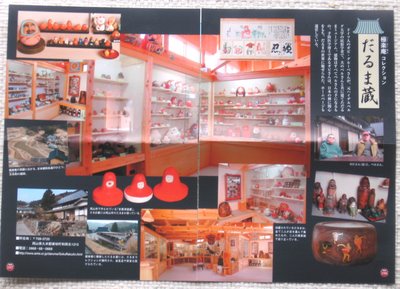
Thank you, Nakamura San, for your great effort with the Daruma lore!
中村さん、ありがとう!!!
To order at Amazon . com Japan
New Book from Nakamura San, 2013
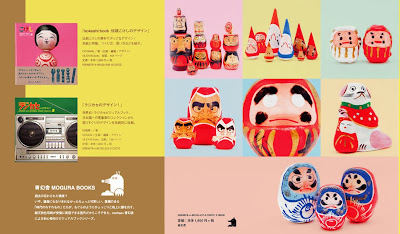

:::::::::::::::::::::::::::::::::::::::::::::::::::::::::::::::::::::::::::::::::::::::::::::::::::::

From DARUMA to daruma - Encyclopedia
達磨からだるまものしり大辞典
中村浩訳 Nakamura Hironobu, 2011
:::::::::::::::::::::::::::::::::::::::::::::::::::::::::::::::::::::::::::::::::::::::::::::::::::::

Zen Nihon Daruma Kenkyuukai 全日本だるま研究会
. MA=RU=DA=RU=MA.
まるだるま ―
あなたに潜むだるま度を引き出せ
Mikurube Shigeru 三廻部
:::::::::::::::::::::::::::::::::::::::::::::::::::::::::::::::::::::::::::::::::::::::::::::::::::::
藤田琢司著
Daruma in the legends of Japan

ISBN : 978-4-88182-229-6
日本の達磨伝説の調査は未開拓の分野であり、伝説自体が一般にあまり知られていない存在である。これらの達磨伝説の中から興味深いものを紹介。豊かに広がっていた達磨の世界と、日本人の達磨に寄せる思いに迫る。
オーソドックスな達磨の伝記
Orthodox legends
達磨、碁を打つ老僧に出会う
Meeting an old monk playing GO
達磨、論語のにおいを嗅ぐ
Smelling of Confucius
達磨、手足を失う
Loosing arms and legs
達磨、まぶたを切り落とす―茶のはじまり
Cutting his eyelids, the beginning of tea
達磨、前歯を打ち折られる
Breaking his front teeth
達磨、日本に渡来する
Coming to Japan
達磨が日本に来た理由
Why did Daruma come to Japan ?
達磨、松島の風景を眺める
Looking at the landscape of Matsushima
達磨、聖徳太子と和歌を交わす
Exchanging Waka poems with Shotoku Taishi
達磨は観音の化身?文殊の化身?
Daruma, an incarnation of Kannon? or Monju?
達磨、栄西禅師として誕生する
Living on as Zen priest Eisai
達磨、動物に変身する
Changing into animals
達磨、出羽の国におもむく
Going North to Dewa
達磨の袈裟―法隆寺献納宝物 - Daruma no Kesa
Treasures at temple Horyuji
二つの達磨忌
Two days of Daruma's Death Memorial
. 達磨大師由来の袈裟 - Daruma no Kesa .
:::::::::::::::::::::::::::::::::::::::::::::::::::::::::::::::::::::::::::::::::::::::::::::::::::::
MORE BOOKS ABOUT . . . DARUMA
McFarland, H. Neill.
Daruma: The Founder of Zen in Japanese Art and Popular Culture.
Kido Chuutaroo 木戸忠太郎
Daruma to sono shosoo 達磨と其諸相
・Minegishi Kanji 峰岸勘次
・Engi Daruma 縁起だるま 高崎だるまとその商園
Hirose Seishi 広瀬正史
Yoku Wakaru Daruma San よくわかるだるまさん
Yoshino Hiroko 吉野裕子
Daruma no Minzokugaku ダルマの民俗学
Daruma Days, book by Terry Watada
ooo ooo ooo ooo ooo ooo ooo ooo ooo ooo ooo ooo
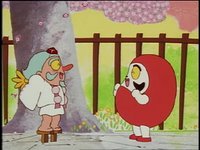
だるまちゃんとてんぐちゃん. Little Daruma & Little Tengu
By Satoshi Kako 加古 里子
.......................................................................

YUKO-CHAN AND THE DARUMA DOLL
- SUNNY SEKI
Yuko-chan and the Daruma Doll, a gorgeous book by author/illustrator Sunny Seki, takes readers on a journey into ancient Japan and the story behind the famous Daruma Doll.
Yuko-chan, an adventurous blind orphan, is able to do amazing things. She confronts a burglar in the dead of night, and crosses treacherous mountain passes to deliver food to hungry people. During her travels, Yuko-chan trips and tumbles down a snowy cliff. She discovers a strange thing as she waits for help: her tea gourd, regardless of how she drops it, always lands right-side-up. The tea has frozen in the bottom of the gourd! Inspired by this, she creates the famous Daruma doll toy, which rights itself when tipped—a true symbol of resilience.
Thanks to Yuko-chan's invention, the villagers are able to earn a living and feed themselves by selling the dolls. Yuko-chan never gave up, no matter the obstacles she faced, and the Daruma doll is a charming reminder of the power of perseverance.
- reference
.......................................................................

The revolt of the Darumas
by Winifred Esther Wise
Three one-eyed darumas earn their second eye in spite of their revolt.
:::::::::::::::::::::::::::::::::::::::::::::::::::::::::::::::::::::::::::::::::::::::::::::::::::::
. Paint your own Daruma 達磨画入門 - Booklist .
墨絵の達磨画入門
達磨大師とだるまさんを描く
Painting Ink paintings of Daruma
干場哲鳳/著
ISBNコード 4-8170-3953-1
日貿出版社
.....
開運だるまの生涯
Kaiun Daruma no Shogai ... the Life of Luck-bringing Daruma
近藤正照 , 1986
ISBN 9784416886007
誠文堂新光社
.....
誰でも描ける達磨画入門
Everyone can paint a Daruma / Introduction
石田豪澄 /秀作社出版
ISBN:4882653702
.....
清空さんの達磨百態画(水墨画の達人シリ-ズ )
本堂清空 /秀作社出版
ISBN:4882651963
.....
新達磨百図
100 Paintings of Daruma / New Edition
石田豪澄 /秀作社出版
ISBN:4882650096
.....
達磨画の描法
How to paint Daruma
石田豪澄 /日貿出版社
ISBN:4817037210
.....
達磨真百態 鑑賞と描法
How to paint 100 in 100 Ways
石田豪澄/著
ISBN: 4-8170-3444-0
:::::::::::::::::::::::::::::::::::::::::::::::::::::::::::::::::::::::::::::::::::::::::::::::::::::

Together with Daruma
作・絵: かがくい ひろし Hiroshi Kagakui
出版社: ブロンズ新社
:::::::::::::::::::::::::::::::::::::::::::::::::::::::::::::::::::::::::::::::::::::::::::::::::::::
日本のだるま 七転び八起き
Nihon no Daruma, Nanakorobi Yaoki
今泉実兵/著 水野康次/著 Imaizumi Jitsuhei
ISBN: 4194024206
:::::::::::::::::::::::::::::::::::::::::::::::::::::::::::::::::::::::::::::::::::::::::::::::::::
自力本願 Do it with your own power !
keshikake Daruma けしかけだるま

出版社: 新風舎 (2003/06)
ISBN-10: 4797422882
LINK to books with - DHARMA
:::::::::::::::::::::::::::::::::::::::::::::::::::::::::::::::::::::::::::::::::::::::::::::::::::::
「 だるまの寝言 」 熊木圓實 著
Daruma no Negoto / What Daruma talks in his Sleep


:::::::::::::::::::::::::::::::::::::::::::::::::::::::::::::::::::::::::::::::::::::::::::::::::::::

Daruma san no o-heso
だるまさんのおへそ
The Navel of Daruma
The foxes go out to look for a Daruma with a navel.
Kitsune books about foxes
http://www.ne.jp/asahi/home/oshima/kitsune.htm
:::::::::::::::::::::::::::::::::::::::::::::::::::::::::::::::::::::::::::::::::::::::::::::::::::::
Some old book
By Kido Chuutaroo 木戸忠太郎
達磨堂刊
起上小法師書集 Okiagari Koboshi Kakiatsume
Taisho 15, Daruma Do Publisher
集 Shuu, Collecting
Showa 3
小達磨集 Ko Daruma shuu
Showa 13, September. 1977
達磨と其諸相 Daruma to sono shosoo
Showa 7
:::::::::::::::::::::::::::::::::::::::::::::::::::::::::::::::::::::::::::::::::::::::::::::::::::::
Nihon no omocha 日本のおもちゃ
Japanese Toys

清水晴風 画 西沢笛畝 画 芸艸堂 版
ISBN 978-4-7538-0242-5
With many examples of Daruma San.
:::::::::::::::::::::::::::::::::::::::::::::::::::::::::::::::::::::::::::::::::::::::::::::::::::::

. Japanese Literature .
:::::::::::::::::::::::::::::::::::::::::::::::::::::::::::::::::::::::::::::::::::::::::::::::::::::
Alphabetical Index of the Daruma Museum
Postcards and books with Daruma
MY ALBUM
- #darumabooks -
:::::::::::::::::::::::::::::::::::::::::::::::::::::::::::::::::::::::::::::::::::::::::::::::::::::::::::::::::::::::::::
[ . BACK to DARUMA MUSEUM TOP . ]
[ . BACK to WORLDKIGO . TOP . ]
:::::::::::::::::::::::::::::::::::::::::::::::::::::::::::::::::::::::::::::::::::::::::::::::::::::::::::::::::::::::::::
:::::::::::::::::::::::::::::::::::::::::::::::::::::::::::::::::::::::::::::::::::::::::::::::::::::
- - - Books about Daruma
:::::::::::::::::::::::::::::::::::::::::::::::::::::::::::::::::::::::::::::::::::::::::::::::::::::
Daruma Encyclopedia
Daruma Daihyakka
カイウン ダルマ ダイヒヤツカ
開運だるま大百科
中村 浩訳 (編集)
Editor: My Daruma Friend Nakamura Hironobu san
全日本だるま研究会
ISBN : 4-8170-8116-3 .日貿出版社
ダルマ、だるま、達磨の全てがこの一冊に !

DARUMA the lucky dolls
だるまは万能な福の神 !!
どんな願いも聞いてくれる”七転びや起き”の縁起物。
There is a double-page where our Daruma Museum is introduced !
だるま蔵

Thank you, Nakamura San, for your great effort with the Daruma lore!
中村さん、ありがとう!!!
To order at Amazon . com Japan
New Book from Nakamura San, 2013


:::::::::::::::::::::::::::::::::::::::::::::::::::::::::::::::::::::::::::::::::::::::::::::::::::::

From DARUMA to daruma - Encyclopedia
達磨からだるまものしり大辞典
中村浩訳 Nakamura Hironobu, 2011
:::::::::::::::::::::::::::::::::::::::::::::::::::::::::::::::::::::::::::::::::::::::::::::::::::::

Zen Nihon Daruma Kenkyuukai 全日本だるま研究会
. MA=RU=DA=RU=MA.
まるだるま ―
あなたに潜むだるま度を引き出せ
Mikurube Shigeru 三廻部
:::::::::::::::::::::::::::::::::::::::::::::::::::::::::::::::::::::::::::::::::::::::::::::::::::::
藤田琢司著
Daruma in the legends of Japan

ISBN : 978-4-88182-229-6
日本の達磨伝説の調査は未開拓の分野であり、伝説自体が一般にあまり知られていない存在である。これらの達磨伝説の中から興味深いものを紹介。豊かに広がっていた達磨の世界と、日本人の達磨に寄せる思いに迫る。
オーソドックスな達磨の伝記
Orthodox legends
達磨、碁を打つ老僧に出会う
Meeting an old monk playing GO
達磨、論語のにおいを嗅ぐ
Smelling of Confucius
達磨、手足を失う
Loosing arms and legs
達磨、まぶたを切り落とす―茶のはじまり
Cutting his eyelids, the beginning of tea
達磨、前歯を打ち折られる
Breaking his front teeth
達磨、日本に渡来する
Coming to Japan
達磨が日本に来た理由
Why did Daruma come to Japan ?
達磨、松島の風景を眺める
Looking at the landscape of Matsushima
達磨、聖徳太子と和歌を交わす
Exchanging Waka poems with Shotoku Taishi
達磨は観音の化身?文殊の化身?
Daruma, an incarnation of Kannon? or Monju?
達磨、栄西禅師として誕生する
Living on as Zen priest Eisai
達磨、動物に変身する
Changing into animals
達磨、出羽の国におもむく
Going North to Dewa
達磨の袈裟―法隆寺献納宝物 - Daruma no Kesa
Treasures at temple Horyuji
二つの達磨忌
Two days of Daruma's Death Memorial
. 達磨大師由来の袈裟 - Daruma no Kesa .
:::::::::::::::::::::::::::::::::::::::::::::::::::::::::::::::::::::::::::::::::::::::::::::::::::::
MORE BOOKS ABOUT . . . DARUMA
McFarland, H. Neill.
Daruma: The Founder of Zen in Japanese Art and Popular Culture.
Kido Chuutaroo 木戸忠太郎
Daruma to sono shosoo 達磨と其諸相
・Minegishi Kanji 峰岸勘次
・Engi Daruma 縁起だるま 高崎だるまとその商園
Hirose Seishi 広瀬正史
Yoku Wakaru Daruma San よくわかるだるまさん
Yoshino Hiroko 吉野裕子
Daruma no Minzokugaku ダルマの民俗学
Daruma Days, book by Terry Watada
ooo ooo ooo ooo ooo ooo ooo ooo ooo ooo ooo ooo

だるまちゃんとてんぐちゃん. Little Daruma & Little Tengu
By Satoshi Kako 加古 里子
.......................................................................

YUKO-CHAN AND THE DARUMA DOLL
- SUNNY SEKI
Yuko-chan and the Daruma Doll, a gorgeous book by author/illustrator Sunny Seki, takes readers on a journey into ancient Japan and the story behind the famous Daruma Doll.
Yuko-chan, an adventurous blind orphan, is able to do amazing things. She confronts a burglar in the dead of night, and crosses treacherous mountain passes to deliver food to hungry people. During her travels, Yuko-chan trips and tumbles down a snowy cliff. She discovers a strange thing as she waits for help: her tea gourd, regardless of how she drops it, always lands right-side-up. The tea has frozen in the bottom of the gourd! Inspired by this, she creates the famous Daruma doll toy, which rights itself when tipped—a true symbol of resilience.
Thanks to Yuko-chan's invention, the villagers are able to earn a living and feed themselves by selling the dolls. Yuko-chan never gave up, no matter the obstacles she faced, and the Daruma doll is a charming reminder of the power of perseverance.
- reference
.......................................................................

The revolt of the Darumas
by Winifred Esther Wise
Three one-eyed darumas earn their second eye in spite of their revolt.
:::::::::::::::::::::::::::::::::::::::::::::::::::::::::::::::::::::::::::::::::::::::::::::::::::::
. Paint your own Daruma 達磨画入門 - Booklist .
墨絵の達磨画入門
達磨大師とだるまさんを描く
Painting Ink paintings of Daruma
干場哲鳳/著
ISBNコード 4-8170-3953-1
日貿出版社
.....
開運だるまの生涯
Kaiun Daruma no Shogai ... the Life of Luck-bringing Daruma
近藤正照 , 1986
ISBN 9784416886007
誠文堂新光社
.....
誰でも描ける達磨画入門
Everyone can paint a Daruma / Introduction
石田豪澄 /秀作社出版
ISBN:4882653702
.....
清空さんの達磨百態画(水墨画の達人シリ-ズ )
本堂清空 /秀作社出版
ISBN:4882651963
.....
新達磨百図
100 Paintings of Daruma / New Edition
石田豪澄 /秀作社出版
ISBN:4882650096
.....
達磨画の描法
How to paint Daruma
石田豪澄 /日貿出版社
ISBN:4817037210
.....
達磨真百態 鑑賞と描法
How to paint 100 in 100 Ways
石田豪澄/著
ISBN: 4-8170-3444-0
:::::::::::::::::::::::::::::::::::::::::::::::::::::::::::::::::::::::::::::::::::::::::::::::::::::

Together with Daruma
作・絵: かがくい ひろし Hiroshi Kagakui
出版社: ブロンズ新社
:::::::::::::::::::::::::::::::::::::::::::::::::::::::::::::::::::::::::::::::::::::::::::::::::::::
日本のだるま 七転び八起き
Nihon no Daruma, Nanakorobi Yaoki
今泉実兵/著 水野康次/著 Imaizumi Jitsuhei
ISBN: 4194024206
:::::::::::::::::::::::::::::::::::::::::::::::::::::::::::::::::::::::::::::::::::::::::::::::::::
自力本願 Do it with your own power !
keshikake Daruma けしかけだるま

出版社: 新風舎 (2003/06)
ISBN-10: 4797422882
LINK to books with - DHARMA
:::::::::::::::::::::::::::::::::::::::::::::::::::::::::::::::::::::::::::::::::::::::::::::::::::::
「 だるまの寝言 」 熊木圓實 著
Daruma no Negoto / What Daruma talks in his Sleep


:::::::::::::::::::::::::::::::::::::::::::::::::::::::::::::::::::::::::::::::::::::::::::::::::::::
Daruma san no o-heso
だるまさんのおへそ
The Navel of Daruma
The foxes go out to look for a Daruma with a navel.
Kitsune books about foxes
http://www.ne.jp/asahi/home/oshima/kitsune.htm
:::::::::::::::::::::::::::::::::::::::::::::::::::::::::::::::::::::::::::::::::::::::::::::::::::::
Some old book
By Kido Chuutaroo 木戸忠太郎
達磨堂刊
起上小法師書集 Okiagari Koboshi Kakiatsume
Taisho 15, Daruma Do Publisher
集 Shuu, Collecting
Showa 3
小達磨集 Ko Daruma shuu
Showa 13, September. 1977
達磨と其諸相 Daruma to sono shosoo
Showa 7
:::::::::::::::::::::::::::::::::::::::::::::::::::::::::::::::::::::::::::::::::::::::::::::::::::::
Nihon no omocha 日本のおもちゃ
Japanese Toys

清水晴風 画 西沢笛畝 画 芸艸堂 版
ISBN 978-4-7538-0242-5
With many examples of Daruma San.
:::::::::::::::::::::::::::::::::::::::::::::::::::::::::::::::::::::::::::::::::::::::::::::::::::::

. Japanese Literature .
:::::::::::::::::::::::::::::::::::::::::::::::::::::::::::::::::::::::::::::::::::::::::::::::::::::
Alphabetical Index of the Daruma Museum
Postcards and books with Daruma
MY ALBUM
- #darumabooks -
:::::::::::::::::::::::::::::::::::::::::::::::::::::::::::::::::::::::::::::::::::::::::::::::::::::::::::::::::::::::::::
[ . BACK to DARUMA MUSEUM TOP . ]
[ . BACK to WORLDKIGO . TOP . ]
:::::::::::::::::::::::::::::::::::::::::::::::::::::::::::::::::::::::::::::::::::::::::::::::::::::::::::::::::::::::::::
12/09/2006
Sake and Daruma
[ . BACK to TOP . ]
:::::::::::::::::::::::::::::::::::::::::::::::::::::::::::::::::::::::::::::::::::::::::::::::::::::
Sake, Ricewine and Daruma
Nihonshuu, 日本酒, the Drink of Japan
quote
Anyone who has ever been to Japan has probably fallen under the spell of a soothing cup of sake at one time or another. An encounter with Japan's favorite libation is bound to be memorable.....
In a land where so much real business takes place off the record, sake is the oil that keeps the wheels of society turning smoothly.
The Buddhist version of Sake is called
the Water of Wisdom, Hanya no Mizu, 般若の水,
and consumed even by monks and priests at prestigeous temple compounds.
source : The Insider's Guide to Sake
Philip Harper

:::::::::::::::::::::::::::::::::::::::::::::::::::::::::::::::::::::::::::::::::::::::::::::::::::
quote
The Origin of Sake
Wet rice cultivation started in Japan nearly 2,500 years ago, and the production of sake seems to have come with it. Initially, it was produced by chewing up and spitting rice into a large bowl to ferment. This "kuchikami" sake was replaced many centuries later with the discovery of yeast, which also increased the alcoholic content.
Sake also had an important social function. Drinking sake brings the gods among people, assisting them to cooperate and live together, easing relationships within the community. For this reason, sake was not usually drunk alone, but with others. It is also always placed on the grave of dead relatives along with an item of food.
Different types of Sake
Sake is traditionally served hot in the winter from a small earthen-ware bottles (tokkuri) and cups (sakazuki), but special kinds of sake are now brewed for drinking cold or on ice as desired. The varieties of sake are determined by the quality of ingredients used and standards set by law. The three main types of sake are:
Ginjo-shu (吟醸酒)
Premium sake made from choice ingredients where rice is not polished to more than 60% of its weight-using the pure starch center of the grain. The enhanced aromatic fragrance and potent flavour can resemble the taste of some western wines and is consumed mainly with sashimi or as an after-dinner drink.
Junmai-shu (純米酒)
A 'pure' sake brewed from only water and koji rice which is not polished by more than 70%. Its features are the distinctively full-bodied flavour and aroma, and is most commonly served in izakaya bars.
Honjozo-shu (本醸造酒)
Used with the same ingredients as Junmaishu yet has brewing alcohol added to help produce a mild taste and fragrant aroma. When mixed with Ginjoshu, the resulting sake is known to be the most delicious, refined and expensive of all.
quote : www.pref. saga.jp
:::::::::::::::::::::::::::::::::::::::::::::::::::::::::::::::::::::::::::::::::::::::::::::::::::

- source : imayo tsukasa Niigata -
:::::::::::::::::::::::::::::::::::::::::::::::::::::::::::::::::::::::::::::::::::::::::::::::::::
- quote -
miki お神酒 Shinshu
Rice wine (sake) offered to the kami, a necessary part of the food offerings known as shinsen. Usually referred to as omiki, or alternately as shinshu, the term miki is a combination of two characters, the honorific mi and the character for "wine" (ki).
As such, it originally derived from a term for wine offered to someone in an exalted position. In ancient documents, miki is also called miwa, and the deity Miwa no kami is thus famous as the kami who presides over sake.
Likewise, the term kushi is found in the songs of the Kojiki as another name for miki, while in Okinawa, one still finds the term ugusu. This word is thought to derive from the ancient view of the "auspicious" (kizui) effect of sake, while another theory links the word to kusuri or "medicine."
All these examples demonstrate that miki has been considered essential to kami worship from legendary times until the present. It is believed that by drinking miki together with the kami to whom it is offered, the celebrants can deepen their communion with the kami. by reaching a state of mind and body not normally experienced in everyday life.
Thus, the meaning of miki is explained as referring to deepening exchange with the kami. There are numerous varieties of miki, including white rice wine and black rice wine (shiroki and kuroki), unrefined rice wine (nigorizake), refined rice wine (sumisake or seishu), and sweet rice wine (hitoyozake).
Likewise, there are several methods of brewing.
Examples the ancient period include a strong "wine of eight-fold brewing" (yashioori no sake), and another "overnight" type of wine called reishu, which ferments when chewed. The ritual offerings of certain localities feature kinds of miki that are so thick they can be picked up with chopsticks.
- source : Saito Michiko, kokugakuin
The religious use of sake, (o-miki お神酒)
In the word o-miki, the reading "ki" is assigned to the character for sake. As such, the final meaning would again be akin to "the sake that helps one prosper," but perhaps this time there is a bit more of a religious association. Linguistically, sakae-no-ki changed to sakae-no-ke, sakae-ke and sake-ke before arriving at the vernacular manifestation we use today.
source : JOHN GAUNTNER
:::::::::::::::::::::::::::::::::::::::::::::::::::::::::::::::::::::::::::::::::::::::::::::::::::::::
I have written extensively about
Tokkuri - Drinking Hot Sake with Daruma 徳利とだるま
BACKUP TEXT only
Sakazuki - Small cups to drink Sake 杯 とだるま
Sakadaru 酒樽 sake barrel, sake cask and wooden masu 升 cups
Sake Matsuri 酒祭 Sake festival in November
Shrine Hibita Jinja 比々多神社, Isehara, Kanagawa
. WKD : Ricewine, rice wine (sake, saké, saki 酒) .
and related KIGO
Jizake 地酒 local ricewine brands
My Photoalbum about Sake and Daruma
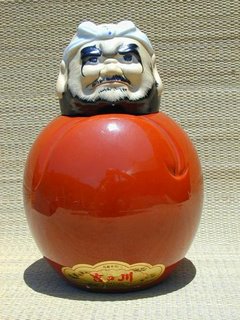
:::::::::::::::::::::::::::::::::::::::::::::::::::::::::::::::::::::::::::::::::::::::::::::::::::::
THE BOOK OF SAKE
Book Review
© ROBBIE SWINNERTON, The Japan Times, December 2006
A Connoisseur's Guide, by Philip Harper.
Kodansha International, 2006, 96 pp.
How the global culinary pendulum does swing. It was not so long ago that drinking sake was considered as exotic, or even as ill advised, as eating raw fish seasoned with green horseradish. Now, with sushi an international fad, Japan's traditional tipple is also starting to make serious inroads onto dining tables around the world.
However, even as misperceptions about sake are cleared up -- that it is not a spirit akin to vodka; that it is not always drunk hot out of thimble-size cups; that it does not necessarily cause hangovers that feel like being thumped by a sumo wrestler -- there are still many barriers holding it back from gaining more widespread acceptance.
As with wine -- with which, fairly or otherwise, it must be compared -- sake comes in a daunting array of labels and with a bewildering vocabulary. Unlike wine, though, there are fewer clues to help break through the ignorance barrier. Sake does not come in two readily identifiable colors (red or white), with clearly defined varietals (such as Chardonnay or Merlot) that give clues about its flavor and character.
But the biggest hindrance to understanding sake is that there is still not enough written (in English, at any rate) on the subject. Sake is a foreign country and we need good guidebooks to help us to find our way, pointing out both the highlights and the areas to avoid, with clear, concise translations of essential phrases.
Few people are better qualified to show us around than Philip Harper. Not only was he the first Westerner to join the workforce of a kura (sake brewery), he is the only foreigner ever to reach the exalted rank of toji (brewmaster). But it is not just his accomplishment in breaking into such an arcane world that makes Harper such a good guide. After 15 years in the business, he is just as enthusiastic about his calling as when he started. Not only does he still remember his first sips of sake, he understands that to appreciate this heady brew we do not need to know the history and jargon. We just need to open a bottle (or two) and start drinking.
That is why his lavishly illustrated new book, most aptly subtitled "A Connoisseur's Guide," starts out with fundamentals. Which kinds of sake should be chilled before being served? Which are better heated? As Harper writes, "there are persuasive reasons to enjoy sake at all temperatures [but] finding the sweet spot for the particular sake you are drinking will double your pleasure."
He also tackles the question of pairing sake with food. Obviously, sake goes brilliantly with Japanese cuisine -- indeed premium ginjo sake served with fine sashimi is one of those sublime matches made in culinary heaven. More robust brews are called for when sitting down to sukiyaki or nibbling on yakitori. Tempura, he suggests, is well suited to a juicy junmai or a flavorful yamahai.
We must acquaint ourselves with terminology of this kind if we are to become connoisseurs (just as a wine drinker needs to know the difference between Sauvignon and Shiraz). Harper introduces the various styles of sake early on, describing the wide spectrum of flavors they offer, but without getting too technical too fast.
He tells us what makes the best aperitif (perhaps a deluxe dai-ginjo) or post-prandial snifter (a rich, well-aged koshu, which he compares to brandy, although it is far closer in nature to amontillado or Pedro Ximenes sherry). He also encourages us to try sake with Chinese or Western cuisine, and even with curries.
Having whetted our appetites -- quite literally, as it is hard to dip into this book without wanting to open a bottle and sip as we read -- Harper draws us into the more rarefied world of sake tasting, introducing an English version of the Sake Flavor Chart developed by sake authority Haruo Matsuzaki. He also explains that the label on your bottle is more than just beautiful (but so inscrutable) calligraphy. It gives useful information that can help you select your brew, and even without knowledge of kanji there are plenty of clues to be deciphered.
But for the would-be connoisseur, it is the second half of the book that is most useful. The differences in the taste of sake derive from regional variations in climate and culture, the various types of rice used in the brewing process and the influence of the brewing guilds. Harper describes these in language that is always clear to the lay reader.
He makes this information practical by including reviews (translated from Matsuzaki's original Japanese) of some 50 different brews from all over Japan. We are given specific names and labels to look out for, along with a run-down of the flavor profiles and brief descriptions of each brewery. Further historical and cultural snippets are inserted via sidebars and boxes dealing with arcana such as the meanings of sake names or how a strain of sake yeast was developed.
© ROBBIE SWINNERTON, The Japan Times, December 2006
:::::::::::::::::::::::::::::::::::::::::::::::::::::::::::::::::::::::::::::::::::::::::::::::::::::
:::::::::::::::::::::::::::::::::::::::::::::::::::::::::::::::::::::::::::::::::::::::::::::::::::::
- reference source : daruma-masamune.co.jp... -
Advertising Daruma Sake
This is a present for a politician who has won an election. He can then paint the second eye into the face, open the barrel of ricewine and start celebrating with his friends !

© PHOTO : nanyo brewery
:::::::::::::::::::::::::::::::::::::::::::::::::::::::::::::::::::::::::::::::::::::::::::::::::::::
Tokkuri, Sake Pourers with two laughing Daruma
Quote:
What a face! Unable to contain himself on one tokkuri, Daruma blasts out with a hearty laugh that one can almost hear on the other. On the base is written 'Heian, Jyuzan' which means it was made in Kyoto by one Jyuzan or Long-life mountain. Holding a brush-like 'duster' in his right hand, possibly to swat the mosquito that hovers on the back of this whimsical pair, Daruma has been painted with lively
animation.
Meiji period, 14.8cm.tall and 6.5cm.across, square form, no box.
http://www.trocadero.com/japanesepottery/
Photo is here !
:::::::::::::::::::::::::::::::::::::::::::::::::::::::::::::::::::::::::::::::::::::::::::::::::::::
Sake World Com. John Gauntner
The Best Online Information !
Ode to Japanese Pottery: Sake Cups and Flasks
by Robert Yellin
http://www.japanesepottery.com/Site_Map/book-yellin/book-yellin.html
:::::::::::::::::::::::::::::::::::::::::::::::::::::::::::::::::::::::::::::::::::::::::::::::::::
SCHNAPS shoochuu shochu 焼酎
A brand from Hiroshima
Made from sweet potatoes

広島ならではの地元にこだわった本格芋焼酎に挑戦しました
25度 達磨 黒麹(紅あずま)720ml瓶
© 中国醸造 広島県

Apron 前掛け maekake
:::::::::::::::::::::::::::::::::::::::::::::::::::::::::::::::::::::::::::::::::::::::::::::::::::::

酒甕に蓋して守るや麦嵐
sakagame ni futa shite moru ya mugi-arashi
for the sake pot
a cover to protect it -
storm on the barley
Yasui Kooji 安井浩司 Yasui Koji
:::::::::::::::::::::::::::::::::::::::::::::::::::::::::::::::::::::::::::::::::::::::::::::::::::::
:::::::::::::::::::::::::::::::::::::::::::::::::::::::::::::::::::::::::::::::::::::::::::::::::::::
[ . BACK to WORLDKIGO TOP . ]
[ . BACK to DARUMA MUSEUM TOP . ]
:::::::::::::::::::::::::::::::::::::::::::::::::::::::::::::::::::::::::::::::::::::::::::::::::::::
:::::::::::::::::::::::::::::::::::::::::::::::::::::::::::::::::::::::::::::::::::::::::::::::::::::
Sake, Ricewine and Daruma
Nihonshuu, 日本酒, the Drink of Japan
quote
Anyone who has ever been to Japan has probably fallen under the spell of a soothing cup of sake at one time or another. An encounter with Japan's favorite libation is bound to be memorable.....
In a land where so much real business takes place off the record, sake is the oil that keeps the wheels of society turning smoothly.
The Buddhist version of Sake is called
the Water of Wisdom, Hanya no Mizu, 般若の水,
and consumed even by monks and priests at prestigeous temple compounds.
source : The Insider's Guide to Sake
Philip Harper

:::::::::::::::::::::::::::::::::::::::::::::::::::::::::::::::::::::::::::::::::::::::::::::::::::
quote
The Origin of Sake
Wet rice cultivation started in Japan nearly 2,500 years ago, and the production of sake seems to have come with it. Initially, it was produced by chewing up and spitting rice into a large bowl to ferment. This "kuchikami" sake was replaced many centuries later with the discovery of yeast, which also increased the alcoholic content.
Sake also had an important social function. Drinking sake brings the gods among people, assisting them to cooperate and live together, easing relationships within the community. For this reason, sake was not usually drunk alone, but with others. It is also always placed on the grave of dead relatives along with an item of food.
Different types of Sake
Sake is traditionally served hot in the winter from a small earthen-ware bottles (tokkuri) and cups (sakazuki), but special kinds of sake are now brewed for drinking cold or on ice as desired. The varieties of sake are determined by the quality of ingredients used and standards set by law. The three main types of sake are:
Ginjo-shu (吟醸酒)
Premium sake made from choice ingredients where rice is not polished to more than 60% of its weight-using the pure starch center of the grain. The enhanced aromatic fragrance and potent flavour can resemble the taste of some western wines and is consumed mainly with sashimi or as an after-dinner drink.
Junmai-shu (純米酒)
A 'pure' sake brewed from only water and koji rice which is not polished by more than 70%. Its features are the distinctively full-bodied flavour and aroma, and is most commonly served in izakaya bars.
Honjozo-shu (本醸造酒)
Used with the same ingredients as Junmaishu yet has brewing alcohol added to help produce a mild taste and fragrant aroma. When mixed with Ginjoshu, the resulting sake is known to be the most delicious, refined and expensive of all.
quote : www.pref. saga.jp
:::::::::::::::::::::::::::::::::::::::::::::::::::::::::::::::::::::::::::::::::::::::::::::::::::

- source : imayo tsukasa Niigata -
:::::::::::::::::::::::::::::::::::::::::::::::::::::::::::::::::::::::::::::::::::::::::::::::::::
- quote -
miki お神酒 Shinshu
Rice wine (sake) offered to the kami, a necessary part of the food offerings known as shinsen. Usually referred to as omiki, or alternately as shinshu, the term miki is a combination of two characters, the honorific mi and the character for "wine" (ki).
As such, it originally derived from a term for wine offered to someone in an exalted position. In ancient documents, miki is also called miwa, and the deity Miwa no kami is thus famous as the kami who presides over sake.
Likewise, the term kushi is found in the songs of the Kojiki as another name for miki, while in Okinawa, one still finds the term ugusu. This word is thought to derive from the ancient view of the "auspicious" (kizui) effect of sake, while another theory links the word to kusuri or "medicine."
All these examples demonstrate that miki has been considered essential to kami worship from legendary times until the present. It is believed that by drinking miki together with the kami to whom it is offered, the celebrants can deepen their communion with the kami. by reaching a state of mind and body not normally experienced in everyday life.
Thus, the meaning of miki is explained as referring to deepening exchange with the kami. There are numerous varieties of miki, including white rice wine and black rice wine (shiroki and kuroki), unrefined rice wine (nigorizake), refined rice wine (sumisake or seishu), and sweet rice wine (hitoyozake).
Likewise, there are several methods of brewing.
Examples the ancient period include a strong "wine of eight-fold brewing" (yashioori no sake), and another "overnight" type of wine called reishu, which ferments when chewed. The ritual offerings of certain localities feature kinds of miki that are so thick they can be picked up with chopsticks.
- source : Saito Michiko, kokugakuin
The religious use of sake, (o-miki お神酒)
In the word o-miki, the reading "ki" is assigned to the character for sake. As such, the final meaning would again be akin to "the sake that helps one prosper," but perhaps this time there is a bit more of a religious association. Linguistically, sakae-no-ki changed to sakae-no-ke, sakae-ke and sake-ke before arriving at the vernacular manifestation we use today.
source : JOHN GAUNTNER
:::::::::::::::::::::::::::::::::::::::::::::::::::::::::::::::::::::::::::::::::::::::::::::::::::::::
I have written extensively about
Tokkuri - Drinking Hot Sake with Daruma 徳利とだるま
BACKUP TEXT only
Sakazuki - Small cups to drink Sake 杯 とだるま
Sakadaru 酒樽 sake barrel, sake cask and wooden masu 升 cups
Sake Matsuri 酒祭 Sake festival in November
Shrine Hibita Jinja 比々多神社, Isehara, Kanagawa
. WKD : Ricewine, rice wine (sake, saké, saki 酒) .
and related KIGO
Jizake 地酒 local ricewine brands
My Photoalbum about Sake and Daruma

:::::::::::::::::::::::::::::::::::::::::::::::::::::::::::::::::::::::::::::::::::::::::::::::::::::
THE BOOK OF SAKE
Book Review
© ROBBIE SWINNERTON, The Japan Times, December 2006
A Connoisseur's Guide, by Philip Harper.
Kodansha International, 2006, 96 pp.
How the global culinary pendulum does swing. It was not so long ago that drinking sake was considered as exotic, or even as ill advised, as eating raw fish seasoned with green horseradish. Now, with sushi an international fad, Japan's traditional tipple is also starting to make serious inroads onto dining tables around the world.
However, even as misperceptions about sake are cleared up -- that it is not a spirit akin to vodka; that it is not always drunk hot out of thimble-size cups; that it does not necessarily cause hangovers that feel like being thumped by a sumo wrestler -- there are still many barriers holding it back from gaining more widespread acceptance.
As with wine -- with which, fairly or otherwise, it must be compared -- sake comes in a daunting array of labels and with a bewildering vocabulary. Unlike wine, though, there are fewer clues to help break through the ignorance barrier. Sake does not come in two readily identifiable colors (red or white), with clearly defined varietals (such as Chardonnay or Merlot) that give clues about its flavor and character.
But the biggest hindrance to understanding sake is that there is still not enough written (in English, at any rate) on the subject. Sake is a foreign country and we need good guidebooks to help us to find our way, pointing out both the highlights and the areas to avoid, with clear, concise translations of essential phrases.
Few people are better qualified to show us around than Philip Harper. Not only was he the first Westerner to join the workforce of a kura (sake brewery), he is the only foreigner ever to reach the exalted rank of toji (brewmaster). But it is not just his accomplishment in breaking into such an arcane world that makes Harper such a good guide. After 15 years in the business, he is just as enthusiastic about his calling as when he started. Not only does he still remember his first sips of sake, he understands that to appreciate this heady brew we do not need to know the history and jargon. We just need to open a bottle (or two) and start drinking.
That is why his lavishly illustrated new book, most aptly subtitled "A Connoisseur's Guide," starts out with fundamentals. Which kinds of sake should be chilled before being served? Which are better heated? As Harper writes, "there are persuasive reasons to enjoy sake at all temperatures [but] finding the sweet spot for the particular sake you are drinking will double your pleasure."
He also tackles the question of pairing sake with food. Obviously, sake goes brilliantly with Japanese cuisine -- indeed premium ginjo sake served with fine sashimi is one of those sublime matches made in culinary heaven. More robust brews are called for when sitting down to sukiyaki or nibbling on yakitori. Tempura, he suggests, is well suited to a juicy junmai or a flavorful yamahai.
We must acquaint ourselves with terminology of this kind if we are to become connoisseurs (just as a wine drinker needs to know the difference between Sauvignon and Shiraz). Harper introduces the various styles of sake early on, describing the wide spectrum of flavors they offer, but without getting too technical too fast.
He tells us what makes the best aperitif (perhaps a deluxe dai-ginjo) or post-prandial snifter (a rich, well-aged koshu, which he compares to brandy, although it is far closer in nature to amontillado or Pedro Ximenes sherry). He also encourages us to try sake with Chinese or Western cuisine, and even with curries.
Having whetted our appetites -- quite literally, as it is hard to dip into this book without wanting to open a bottle and sip as we read -- Harper draws us into the more rarefied world of sake tasting, introducing an English version of the Sake Flavor Chart developed by sake authority Haruo Matsuzaki. He also explains that the label on your bottle is more than just beautiful (but so inscrutable) calligraphy. It gives useful information that can help you select your brew, and even without knowledge of kanji there are plenty of clues to be deciphered.
But for the would-be connoisseur, it is the second half of the book that is most useful. The differences in the taste of sake derive from regional variations in climate and culture, the various types of rice used in the brewing process and the influence of the brewing guilds. Harper describes these in language that is always clear to the lay reader.
He makes this information practical by including reviews (translated from Matsuzaki's original Japanese) of some 50 different brews from all over Japan. We are given specific names and labels to look out for, along with a run-down of the flavor profiles and brief descriptions of each brewery. Further historical and cultural snippets are inserted via sidebars and boxes dealing with arcana such as the meanings of sake names or how a strain of sake yeast was developed.
© ROBBIE SWINNERTON, The Japan Times, December 2006
:::::::::::::::::::::::::::::::::::::::::::::::::::::::::::::::::::::::::::::::::::::::::::::::::::::
:::::::::::::::::::::::::::::::::::::::::::::::::::::::::::::::::::::::::::::::::::::::::::::::::::::
- reference source : daruma-masamune.co.jp... -
Advertising Daruma Sake
This is a present for a politician who has won an election. He can then paint the second eye into the face, open the barrel of ricewine and start celebrating with his friends !

© PHOTO : nanyo brewery
:::::::::::::::::::::::::::::::::::::::::::::::::::::::::::::::::::::::::::::::::::::::::::::::::::::
Tokkuri, Sake Pourers with two laughing Daruma
Quote:
What a face! Unable to contain himself on one tokkuri, Daruma blasts out with a hearty laugh that one can almost hear on the other. On the base is written 'Heian, Jyuzan' which means it was made in Kyoto by one Jyuzan or Long-life mountain. Holding a brush-like 'duster' in his right hand, possibly to swat the mosquito that hovers on the back of this whimsical pair, Daruma has been painted with lively
animation.
Meiji period, 14.8cm.tall and 6.5cm.across, square form, no box.
http://www.trocadero.com/japanesepottery/
Photo is here !
:::::::::::::::::::::::::::::::::::::::::::::::::::::::::::::::::::::::::::::::::::::::::::::::::::::
Sake World Com. John Gauntner
The Best Online Information !
Ode to Japanese Pottery: Sake Cups and Flasks
by Robert Yellin
http://www.japanesepottery.com/Site_Map/book-yellin/book-yellin.html
:::::::::::::::::::::::::::::::::::::::::::::::::::::::::::::::::::::::::::::::::::::::::::::::::::
SCHNAPS shoochuu shochu 焼酎
A brand from Hiroshima
Made from sweet potatoes

広島ならではの地元にこだわった本格芋焼酎に挑戦しました
25度 達磨 黒麹(紅あずま)720ml瓶
© 中国醸造 広島県

Apron 前掛け maekake
:::::::::::::::::::::::::::::::::::::::::::::::::::::::::::::::::::::::::::::::::::::::::::::::::::::

酒甕に蓋して守るや麦嵐
sakagame ni futa shite moru ya mugi-arashi
for the sake pot
a cover to protect it -
storm on the barley
Yasui Kooji 安井浩司 Yasui Koji
:::::::::::::::::::::::::::::::::::::::::::::::::::::::::::::::::::::::::::::::::::::::::::::::::::::
:::::::::::::::::::::::::::::::::::::::::::::::::::::::::::::::::::::::::::::::::::::::::::::::::::::
[ . BACK to WORLDKIGO TOP . ]
[ . BACK to DARUMA MUSEUM TOP . ]
:::::::::::::::::::::::::::::::::::::::::::::::::::::::::::::::::::::::::::::::::::::::::::::::::::::
Subscribe to:
Posts (Atom)

